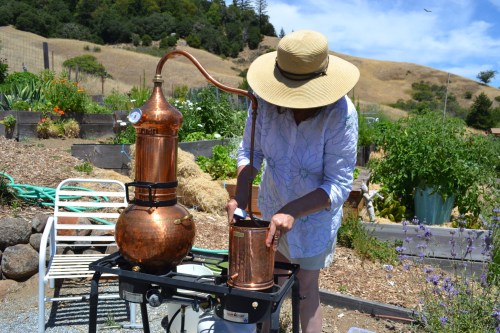This post is generously sponsored by Benjamin Franklin Plumbing Bay Area. Benjamin Franklin Plumbing Bay Area specializes in all residential plumbing work, from installations to maintenance and repairs. They have been serving the San Francisco Bay Area for over 25 years.
Lovely-smelling lavender has been prized around the globe for centuries, for the soothing quality of its distinct scent. The ancient Egyptians used it in cosmetics. The ancient Greeks and Romans employed it for perfume and for healing practically everything, from stomach and kidney ailments to dropsy, jaundice, migraines and insect bites. In late medieval times, doctors carried walking sticks with lavender and other herbs tucked into their tops. Queen Victoria is credited with bringing lavender into the home for scenting and cleaning, where it remains popular today. Learn more about the history of lavender.
Luckily it’s easy to create your own gentle yet effective lavender cleaner for bathroom and kitchen counters, and other areas throughout the house. Pour distilled white vinegar into a spray bottle and add 10-40 drops of lavender essential oil (available at many markets and online sources), depending on the size of the bottle and your taste for the scent. This simple formula offers a natural way to clean and sanitize bathroom and kitchen counter tops, bathtubs and toilets.
Why is lavender so effective for cleaning? The herb is an antifungal and an antimicrobial. While it works hard, it smells lovely. Learn about other DIY cleansers to make with lavender and other herbal cleansers you can make yourself.
I’d long wanted to take part in a lavender distillation, the process by which lavender is separated into essential oil and hydrosol, which is the byproduct of oil creation. I was thrilled to take part in a lavender distillation led by Cheryl Fromholzer of Gathering Thyme, a woman-owned herb store and education center in San Rafael, CA.
We began by separating lavender buds from stalks and packing them pretty tightly into the column of the traditional copper still, or alembic.
The column was placed onto water-filled urn and sealed so no steam would escape during the distillation.
Cheryl attached the pipes, which led to a small condenser.
Then tubing was added from the condenser, and the columned pot was brought to a boil. When the water heated and boiled, the steam from that process caused the lavender to release its oils, which collected at the top of the alembic. The oils then traveled to the condenser, where they cooled, and out through tubing to be collected in jars.
The lavender essential oil floats to the top and can be separated by skimming it off or by using an essencier. The remaining liquid is lavender hydrosol, which can be used much the same way as essential oil, though it is much less potent. (It takes 30 pounds of lavender to make a 15 Ml bottle of essential oil!)
You don’t need an alembic still to create oils and hydosols at home. Hydrosols make wonderful and calming sprays for rooms, face and body, in addition to other uses.
Best yet, lavender is easy to grow, even in a small or container garden, with decent sun, moderate water, and an alkaline soil with good drainage.
Our distillation process took a few hours, so we enjoyed the San Geronimo Community Garden and explored the medicinal properties of the plants there, many of which would also make terrific hydrosols and oils.
More herbal classes and resources, including a Lavender Distillation workshop on July 10, can be found at Gathering Thyme.
More lavender and herbal crafts and activities can be found in Fed Up with Frenzy: Slow Parenting in a Fast-Moving World, which contains 300+ more fun family activities.
Thank you again to sponsor Benjamin Franklin Plumbing. The views expressed are my own.
Photos: Susan Sachs Lipman (Top photo courtesy of Cheryl Fromholzer)

 Google Plus
Google Plus



































































































































